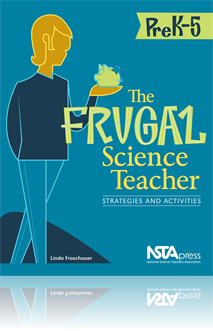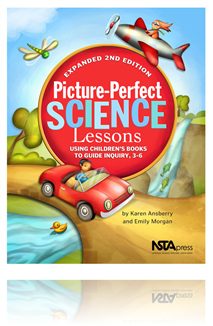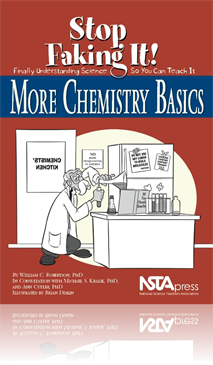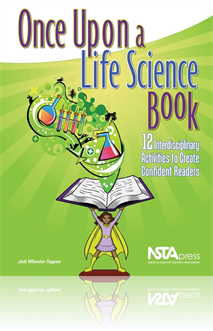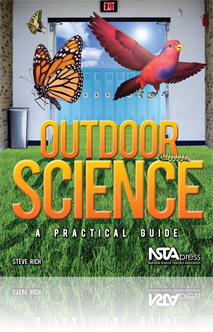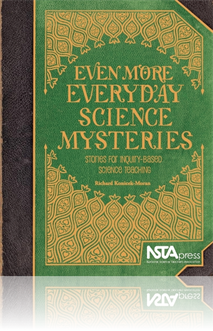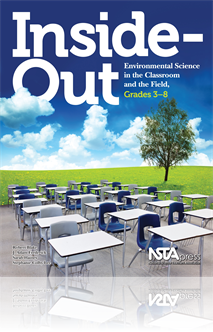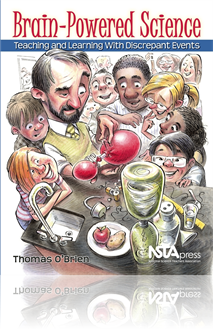All Resources
eBook
The Frugal Science Teacher, PreK-5: Strategies and Activities (e-book)
Teachers of all grades and disciplines often dip into their own wallets to outfit their classrooms with materials and supplies that school and district budgets can’t—or won’t—cover. Science teachers tend to find themselves supplementing their...
Book Chapter
Earth Hounds: Dr. Xargle's Book of Earth Hounds and Seven Blind Mice
Learners develop understandings of the differences between observations and inferences by analyzing Dr. Xargle's comical, yet misguided, attempts to teach his students about human babies. Learners then make observations and inferences of "mystery sam...
eBook
More Chemistry Basics: Stop Faking It! Finally Understanding Science So You Can Teach It (e-book)
Overwhelmed by orbitals? Terrified of thermodynamics? Agitated by acids and bases? Have no fear! This follow-up to the award-winning Chemistry Basics will clear up your chemistry woes. ...
NSTA Press Book
Picture-Perfect Science Lessons, Expanded 2nd Edition: Using Children's Books to Guide Inquiry, 3-6
How do you improve upon perfection? For years, new and experienced elementary school teachers alike have extolled the virtues of Picture-Perfect Science Lessons—the expertly combined appeal of children’s picture books with standards-based science...
By Karen Ansberry, Emily Morgan
eBook
Science Education Leadership: Best Practices for the New Century (e-book)
Achieving science literacy for every student is the common goal of all science educators. It requires leaders from a broad spectrum of the science education field to band together and clearly define how to achieve this goal and provide the tools for ...
eBook
Once Upon a Life Science Book: 12 Interdisciplinary Activities to Create Confident Readers (e-book)
Reading skills and life science come together in this engaging new book for middle school teachers. Once Upon a Life Science Book makes it easy for teachers to improve their students’ reading abilities and teach science content simultaneously throu...
eBook
Outdoor Science: A Practical Guide (e-book)
Research shows that environment-centered education improves student achievement. Whatever your school’s setting—urban, suburban, or rural—you can create stimulating outdoor classrooms for your students, with a little help from Outdoor Science. ...
eBook
Even More Everyday Science Mysteries: Stories for Inquiry-Based Science Teaching (e-book)
What are the odds of a meteor hitting your house? What are “warm” clothes anyway? Do you get “more” sunlight from Daylight Saving Time? Everyone loves a good mystery and these unfold in the 15 stories presented in Even More Everyday Science M...
eBook
Inside-Out: Environmental Science in the Classroom and the Field, Grades 3–8 (e-book)
Teachers seeking new ways to integrate Earth science, chemistry, physical geography, and life science into a study of the environment should just step outside! So say the authors of Inside-Out: Environmental Science in the Classroom and the Field, Gr...
NSTA Press Book
Uncovering Student Ideas in Physical Science, Volume 1: 45 New Force and Motion Assessment Probes
Nationally known science educator Page Keeley—principal author of the hugely popular, four-volume NSTA Press series Uncovering Students Ideas in Science—has teamed up with physicist and science educator Rand Harrington to write this first volume ...
By Page Keeley, Rand Harrington
eBook
Brain-Powered Science: Teaching and Learning With Discrepant Events (e-book)
• How can a long metal needle pass through a balloon without popping it? • How can water flow at very different rates through two identical funnels? • How can a stick, placed on a table under several sheets of newspaper and extended over t...
Book Chapter
The purpose of this assessment probe is to comprehensively elicit students' ideas about the relationship between force and motion. The list of possible answers includes several distracters that are based on learning research; thus the probe will tell...
Journal Article
This study compares a traditional paper presentation approach and a case study method for the development and improvement of oral communication skills and critical-thinking skills in a class of junior forensic science majors. A rubric for rating perf...
Journal Article
Editorial: The Scientific Method Teaching
Nope, that title is not a typographical error. The following paragraphs are not about teaching the scientific method. That assumption may be easily forgiven, though. JCST’s mission of publishing exemplary works about teaching and learning across th...
Journal Article
The purpose of this study was to assess some of the effects of a nontraditional, experimental learning approach designed to improve rapid acquisition and long-term retention of quantitative communication skills (QCS) such as descriptive and inferenti...
Journal Article
Students in a general education science course made significant gains in scientific reasoning skills when they were taught using carefully designed hands-on activities and writing assignments. The activities required students to make use of scientifi...
Journal Article
Beyond Dissemination in College Science Teaching: An Introduction to Four Core Change Strategies
Within the science, technology, engineering and mathematics (STEM) education community there are repeated calls for the reform of undergraduate teaching. Resulting change efforts often focus on developing and disseminating specific instructional idea...
Book Chapter
The purpose of this assessment probe is to elicit students' description of the motion of an object. The probe uses the context of rolling down and up a hill to determine if students recognize when an object speeds up or slows down or does neither—m...
Book Chapter
The purpose of this assessment probe is to determine what students mean when they use words to describe motion, such as speed, velocity, and acceleration. The probe is designed to reveal students' initial meaning of the word velocity before formally ...
Book Chapter
The purpose of this assessment probe is to elicit students' meaning of words used to describe motion such as speed, velocity, and acceleration. The probe is designed to reveal students' initial qualitative meaning of the word acceleration before form...
Book Chapter
The purpose of this assessment probe is to elicit students' ideas about motion using marbles and ramps. The probe is designed to reveal students' thinking about the factors that affect the time it takes for a marble to roll down a ramp....
Book Chapter
The purpose of this assessment probe is to elicit beginning ideas about force. The probe is designed to reveal whether students generally identify forces as pushes and pulls....
Book Chapter
The purpose of this assessment probe is to elicit beginning ideas about types of forces. The probe is designed to reveal whether students recognize that forces can act both in direct contact with an object and at a distance....
Book Chapter
The purpose of this probe is to examine students' ideas about an imaginary frictionless environment. The probe is designed to reveal students' ideas about the effect of friction on motion....
Book Chapter
The purpose of this assessment probe is to elicit students' ideas related to force, energy, and motion. The probe is designed to identify students who may think about force as being carried by an object, rather than as being an interaction between ob...
Book Chapter
The purpose of this probe is to elicit students' ideas about relative motion. The probe is designed to reveal whether students use Newton's first law of motion to predict where a person would land on a moving object if he or she jumped straight up wh...
Book Chapter
This probe is designed to elicit students' ideas about changing the direction of motion in the absence of air. Many students will have seen movies or television shows in which spaceships turn by banking or using wing flaps. In outer space, where ther...
Book Chapter
The purpose of this assessment probe is to elicit students' ideas about force related to the interaction between inanimate objects. The probe is designed to determine which forces students think act on an object at rest when it is inside a fast-movin...
Book Chapter
The purpose of this assessment probe is to elicit students' ideas about Newton's first law in the context of circular motion. The probe is designed to determine whether students recognize that an object will move in a straight line unless acted on by...
Book Chapter
The purpose of this assessment probe is to elicit students' ideas about falling objects. The probe is designed to find out whether students recognize the role of mass and forces in understanding why heavy and light objects can fall at the same rate....
Book Chapter
The purpose of this assessment probe is to elicit students' ideas about forces. The probe is designed to reveal whether students recognize a situation in which the force applied by one object on another is equal, but opposite, to the force applied by...



